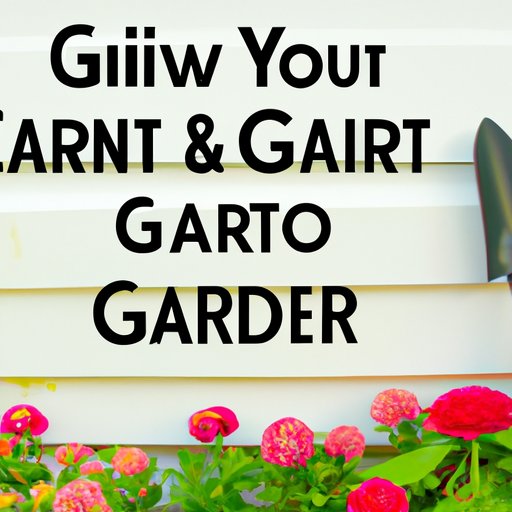Introduction
Gardening is a great way to connect with nature, enjoy fresh air and sunshine, and produce healthy food. It can also be an enjoyable hobby that brings peace and relaxation. Whether you’re a beginner or an experienced gardener, starting a garden can be a rewarding experience. This article will provide an overview of why people should start a garden, as well as a step-by-step guide with tips for beginners.
Reasons Why People Should Start a Garden
There are many benefits to starting a garden. Gardening provides an opportunity to spend time outdoors in nature, which has been linked to improved mental health. According to a study published in the journal Environmental Science & Technology, “green outdoor activities such as gardening have a positive impact on mental health, reducing stress and improving mood.”
Starting a garden can also help reduce stress levels, improve concentration, and increase physical activity. The act of caring for a garden can be calming, while the physical labor involved can lead to a sense of accomplishment. Additionally, growing your own food can be cost-effective and provide access to fresh, nutritious produce.
Step-by-Step Guide on How to Start a Garden
Before you begin planting, there are some important steps you’ll need to take to prepare for your garden. Here’s a step-by-step guide to help you get started:
Choose a Location for Your Garden
The first step is to choose a location for your garden. You’ll want to select an area that gets plenty of sunlight and has good drainage. If possible, try to find a spot that’s close to a water source, such as a hose or spigot.
Prepare the Soil
Once you’ve chosen a location, it’s time to prepare the soil. You can do this by digging up the soil and removing any weeds or debris. You may also want to add compost or other organic matter to improve the quality of the soil. Make sure to break up any large clumps of soil and use a rake to smooth out the surface.
Determine How Much Sunlight Your Garden Will Get
Next, you’ll need to determine how much sunlight your garden will get each day. Most vegetables and flowers need at least six hours of direct sunlight per day, so make sure to pick a spot that gets plenty of sun. If you’re not sure how much sunlight your garden will get, you can measure it with a light meter.
Decide What Plants You Want to Grow
Now it’s time to decide what plants you want to grow in your garden. Consider the climate where you live, the amount of sun your garden will get, and the type of soil you have. You may also want to research different types of plants and decide which are best for your garden. Once you’ve made your selections, write down the names of the plants so you can easily reference them later.
Beginner’s Guide to Starting a Garden
If you’re new to gardening, there are a few things you should consider before you get started. First, you’ll need to research different types of plants and decide which are best for your garden. Different plants require different amounts of maintenance, so make sure to read up on the care instructions for each one. You should also consider the costs associated with starting a garden, such as the cost of soil, tools, and plants.
It’s also important to learn about companion planting and crop rotation. Companion planting involves planting two or more types of plants near each other to benefit both plants. For example, planting tomatoes and basil together can help deter pests from attacking the tomatoes. Crop rotation involves growing different crops in the same space over successive seasons to maintain soil fertility and prevent disease.

Tips for Planning Your Garden
Once you’ve decided on the plants you want to grow, it’s time to start planning your garden. To get started, make a sketch of your garden and estimate how much space each plant will need. Then, decide how you will arrange the plants in your garden. When planting, make sure to leave enough room between the plants for proper growth.

Choosing the Right Plants for Your Garden
When choosing plants for your garden, consider the climate where you live and the amount of sun your garden will get. Make sure to select plants that will thrive in your garden and require minimal maintenance. You may also want to consider growing plants that are drought-tolerant and pest-resistant.

Developing an Irrigation Plan for Your Garden
Once you’ve chosen the plants for your garden, it’s important to develop an irrigation plan. Determine whether irrigation is necessary based on the amount of rainfall your area receives. If irrigation is needed, choose the right system for your garden and learn about water conservation techniques. This will help ensure that your plants receive the water they need without wasting any.
Conclusion
Starting a garden can be a rewarding experience that provides many benefits. By following these steps and tips, you can create the perfect garden for your needs. Remember to choose a location with plenty of sunlight, prepare the soil, select the right plants, and develop an irrigation plan. With a little bit of effort, you can enjoy the fruits of your labor and reap the rewards of a beautiful garden.
(Note: Is this article not meeting your expectations? Do you have knowledge or insights to share? Unlock new opportunities and expand your reach by joining our authors team. Click Registration to join us and share your expertise with our readers.)
